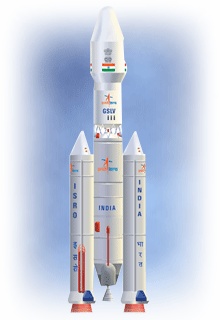Isro to test lunar crew module on GSLV-Mark III in December
01 Nov 2014
India is reentering the lunar mission with the Indian Space Research Organisation's (Isro) plan to send an unmanned crew module on its experimental rocket GSLV-Mark III in December - a mission to simulate earth re-entry flight experiments ahead of taking up manned mission to the moon.
 ''We will send an unmanned crew module on the experimental GSLV-Mark III rocket in December and test its re-entry into the earth's atmosphere for a human space flight plan in future,'' Isro chairman K Radhakrishnan said on the sidelines of the 2014 Engineers Conclave in Bangalore on Thursday.
''We will send an unmanned crew module on the experimental GSLV-Mark III rocket in December and test its re-entry into the earth's atmosphere for a human space flight plan in future,'' Isro chairman K Radhakrishnan said on the sidelines of the 2014 Engineers Conclave in Bangalore on Thursday.
The GSLV- Mk III or Geosynchronous Satellite Launch Vehicle Mark III, which is currently under development, is conceived and designed to make India fully self-reliant in launching heavier communication satellites of INSAT-4 class, which weigh 4,500 to 5,000 kg.
It would also enhance the capability of the country to improve competitiveness in the multimillion dollar commercial launch market. The vehicle envisages multi-mission launch capability for GTO, LEO, Polar and intermediate circular orbits.
The first experimental mission of the GSLV-Mark III will carry a crew module weighing 3.6 tonnes and put it in orbit 100-120 km and bring it back to Earth for checking its re-entry capabilities so as to assess the feasibility of sending two Indian astronauts in the future space flights.
Once the crew module re-enters the Earth's atmosphere successfully, it will use a parachute that will open up and fall into the sea from where it would be retrieved. The landing point of module is tentatively planned in the Bay of Bengal, about 450 km away from Andaman Islands, Radhakrishnan said.
"We are getting ready for the launch, it should happen in the first half of December," the Isro chairman said. The 630-tonne GSLV-Mk III will carry a crew module of 3.65 tonnes.
"Certain reviews are going on at the moment, we expect by December first half we should be able to have the launch," he added.
While in the actual human space flight the lunar module will have to be in an orbit at a distance of 270 km, Isro's experimental flight will take the crew module to a height of 100-120km above earth to test its heat shield survival chances at about 1,500 degrees Celsius during the re-entry into the atmosphere.
Isro has budgeted Rs145 crore for the experimental flight, including development of the crew module capable of accommodating at least two astronauts, their space suits, life support systems and other ingredients like space-compliant food that was tested by the Mysore-based Institute of Food Technology.
The GSLV-Mark III heavy rocket will use liquid nitrogen at super cooled temperature and gaseous nitrogen instead of liquid hydrogen and liquid oxygen, he said. The crew module will be assembled and lifted off from the Sriharikota space port in Andhra Pradesh, about 90 km northeast of Chennai, from where the Mars Orbiter Mission was sent.
The exact timing of the launch of GSLV-Mark III will depend on weather conditions, data analysis and fine-tuning the new vehicle, Radhakrishnan said.
The news came hours before China successfully launched its experimental re-entry mission to the moon with its unmanned orbiter landing back on Earth, joining Russia and the US.
On the cryogenic engine, Radhakrishnan said, "That is developing well....This engine is different compared to cryogenic engine used for GSLV. The difference is that it used a staged combustion cycle, and the new one uses gas generator cycle.
"In another five to six weeks, we should be able to have the first firing of that engine on the ground, which we call hot touch- it will be done in Mahendragiri..." Radhakrishnan said, "This experimental flight of GSLV-Mark III provides all the inputs required, and then we can have first developmental flight of GSLV-Mark III in two years, that is the schedule at the moment.''
The first development flight (GSLV Mk-III D1) with an operational cryogenic stage is planned between 2016 to 2017. The second development flight (GSLV Mk-III D2) is planned after one year of GSLV Mk-III D1 flight in 2017 to 2018.













.jpg)






.jpg)









